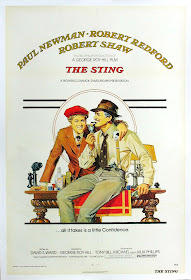"You have to keep this con even after you take his money.
He
can't know you took him." -Henry Gondorff
 |
| Via. |
One great script, two gorgeous men, and a lot of good
acting; that, in essence, sums up the classic 1973 con movie, The Sting. In all seriousness though,
there is so much to keep you entertained while watching The Sting -from the acting to the fast paced dialogue to all the plot twists and turns- I’m not quite sure how someone could not like
this movie.
 |
| The gorgeous men of The Sting. Via. |
After the box-office success of the 1967 film, Bonnie and Clyde, 1930’s gangster films
experienced a resurgence in Hollywood. While researching the art and
crime of pickpocketing for a previous film, screenwriter David S. Ward became fascinating with old time
confidence men. Through his research, he got the idea for The Sting: an elaborate script with twists and turns, comedy and
action, and one elaborate con job.
The lead character of Johnny Hooker was actually written
with Robert Redford in mind, however the box office star needed a little
convincing before finally agreeing to take on the role. Even after filming
began, Redford never believed the movie would be such a hit, let alone an Academy Award-winning film that would still be revered today.
 |
| That grin...Via. |
Ironically, Paul Newman’s part of Henry Gondorff was
originally written as a much smaller, more supporting role. Once Newman showed
interest in joining the film, the part was re-written in order to take
advantage of the great (and lucrative) on-screen chemistry between Newman and
Redford.
 |
| Those eyes... Via. |
This wasn’t the first time the duo had worked together. In
1969 Newman and Redford worked together in another crime film: Butch Cassidy and the Sundance Kid.
After the critical and box office success of Butch Cassidy, the studio was more than excited to pair these two
actors together again. Joining them on The Sting as well, was Butch Cassidy
director George Roy Hill. The comfortable and compatible nature of the trio’s partnership is obvious in
both films.
 |
| Redford and Newman on set. Via. |
With just the screenplay and the amazing actors behind the
camera, The Sting was a guaranteed
success (despite Redford’s doubts), but once they added the great sets,
costumes, and music into the mix, The
Sting became a classic.
Being a Chicagoan myself, I love movies that take place in
my city, especially those that depict a historical Chicago. Despite the
majority of the movie being filmed on Hollywood sets, The Sting offers an authentic look at Chicago in the 1930’s. From LaSalle
Street Station to the 43rd Street el stop, you can get a glimpse of the city as it use to be and visualize what it would have been like back
in the day. The color scheme of the film is great too- with muted browns, dark maroons,
and forest greens, it effectively produces the perfect tone for a
depression-struck, but still-tough city that has too much character to give in.
 |
| Shot of LaSalle Street Station. Via. |
In addition to the authentic sets, you also have the costumes
designed by the great Edith Head. Head actually won her 8th and final
Academy Award for the wardrobe she designed for The Sting. During her acceptance speech, she summed up the honor
explaining, “Just imagine, dressing the two handsomest men in the world and
then getting this." I think we can all agree with Edith’s sentiments.
 |
| Costume designer, Edith Head, with Robert Redford. Via. |
But even more than the costumes or scenery, what I love most is
the music. The Sting features several
hits of turn-of-the-century composer, Scott Joplin. His ragtime compositions,
including his most recognizable “The Entertainer,” set the scene in The Sting adding the perfect syncopated rhythm.
Ironically, the ragtime tunes are not of the 1930’s time period; ragtime
actually hit its peak during the first decade of the 20th century, meaning
that Joplin’s music would have already faded into obscurity in the real 1930’s.
Despite this historical misrepresentation, the Joplin-inspired score fits the
movie perfectly, and actually created a temporary ragtime revival in the early 1970’s.
To top off The Sting's perfect combination of visual and auditory components, you have the fantastic Saturday Evening Post-inspired inter-title cards that narrate the
progression of the con. These fabulous illustrations and titles are so unique
and one of a kind. They make the audience feel like they’re flipping through a con playbook while
watching the swindle unfold.
 |
| Via. |
All of these features- the script, the actors, the sets, the
costumes, and the music- all piece together to make a classic and timeless
film. The Sting went on to win 7
Oscars, including Best Picture, Best Director, and Best Screenplay. It is also
(surprisingly) the only film for which Robert Redford was nominated for Best
Actor. The Sting also went on to influence
future con movies, including the 2001 revamp of Oceans 11, which in my opinion displays more characteristic of The Sting rather than its original.
I definitely recommend watching The Sting if you haven’t; it’s a clever and entertaining film that will probably fool
you a couple times too.
 |
| Via. |
Lisa Helene.
And just because:
 |
| So dapper... Via. |
No comments:
Post a Comment